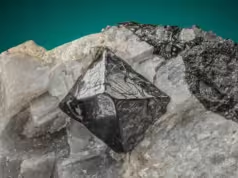Minerals
A mineral is a naturally occurring chemical compound usually of crystalline form and not produced by life processes. A mineral has one specific chemical composition, whereas a rock can be an aggregate of different minerals or mineraloids. The study of minerals is called mineralogy. To meet the definition of “mineral” used by most geologists, a substance must meet five requirements:
Glaucophane
The Glaucophane mineral is named after two Greek words: glaukos, which means “bluish green”; and phainesthai, which means “to appear.” Specimens can be gray, lavender blue, or bluish black. Crystals are slender, often lathlike prisms, with lengthwise striations. Twinning is common. Glaucophane can also be massive, fibrous, or granular. When iron replaces the magnesium in its structure, it is known as ferroglaucophane. Glaucophane occurs in schists formed by high-pressure metamorphism of sodium-rich sediments at low temperatures (up to 400°F/200°C) or by the introduction of sodium into the process. Glaucophane is often accompanied by jadeite, epidote, almandine, and chlorite. It is one of the minerals that are referred to as asbestos. Glaucophane and its associated minerals are known as the glaucophane metamorphic facies. The presence of these minerals indicates the range of temperatures and pressures under which metamorphism occurs.
Anthophyllite
The name anthophyllite comes from the Latin word anthophyllum, which means “clove”—a reference to the mineral’s clove-brown to dark brown color. Specimens can also be pale green, gray, or white. Anthophyllite is usually found in columnar to fibrous masses. Single crystals are uncommon; when found, they are prismatic and usually unterminated. The iron and magnesium content in anthophyllite is variable. The mineral is called ferroanthophyllite when it is iron-rich, sodium-anthophyllite when sodium is present, and magnesioanthophyllite when magnesium is dominant. Titanium and manganese may also be present in the anthophyllite structure. Anthophyllite forms by the regional metamorphism of iron- and magnesium-rich rocks, especially silica-poor igneous rocks. It is an important component of some gneisses and crystalline schists and is found worldwide. Anthophyllite is one of several minerals referred to as asbestos.
Platinum
The first documented discovery of platinum was by the Spaniards in the 1500s, in the alluvial gold mines of the Río Pinto, Colombia. They called it platina del Pinto, from platina, which means “little silver,” thinking that it was an impure ore of silver. It was not recognized as a distinct metal until 1735. It is opaque, silvery gray, and markedly dense. Platinum usually occurs as disseminated grains in ironand magnesium-rich igneous rocks and in quartz veins associated with hematite, chlorite, and pyrolusite. When rocks weather, the heavy platinum accumulates as grains and nuggets in the resulting placer deposits. Crystals are rare, but when found they are cubic. Most platinum for commercial use is recovered from primary deposits. Native platinum typically contains iron and metals such as palladium, iridium, and rhodium.
Anorthoclase
This member of the sodium- and potassium-rich feldspar group takes its name from the Greek word anorthos, which means “not straight”—a reference to its oblique cleavage. Anorthoclase is colorless, white, cream, pink, pale yellow, gray, or green.
Microcline
Used in ceramics and as a mild abrasive, microcline is one of the most common feldspar minerals. It can be colorless, white, cream to pale yellow, salmon pink to red, or bright green to blue-green. Microcline forms short prismatic or tabular crystals that are often of considerable size: single crystals can weigh several tons and reach yards in length. Crystals are often multiply twinned, with two sets of fine lines at right angles to each other. This gives a “plaid” effect that is unique to microcline among the feldspars.
Sanidine
A member of the solid-solution series of potassium and sodium feldspars, sanidine is the high-temperature form of potassium feldspar, forming at 1,065°F (575°C) or above. Crystals are usually colorless or white, glassy, and transparent, but they may also be gray, cream, or occur in other pale tints.
Orthoclase
An important rock-forming mineral, orthoclase is the potassium-bearing end member of the potassium sodium feldspar solid-solution series. It is a major component of granite its pink crystals give granite its typical color.
Copper
Copper was probably the first metal to be used by humans. Neolithic people are believed to have used as a substitute for stone by...
Corundum
Corundum is a mineral that is primarily composed of aluminum oxide (Al2O3) and is one of the naturally occurring crystalline forms of aluminum oxide....
Diamond
The hardest known mineral, diamond is pure carbon. Its crystals typically occur as octahedrons and cubes with rounded edges and slightly convex faces. Crystals may be transparent, translucent, or opaque. They range from colorless to black, with brown and yellow being the most common colors. Other forms include bort or boart (irregular or granular black diamond) and carbonado (microcrystalline masses).
Talc
Talc is a naturally occurring mineral known for its softness, smoothness, and ability to absorb moisture. It is a silicate mineral that is composed...
Bornite (Peacock)
Bornite, commonly referred to as "peacock ore," is a captivating mineral known for its striking and iridescent appearance. This mineral, composed primarily of copper...











































